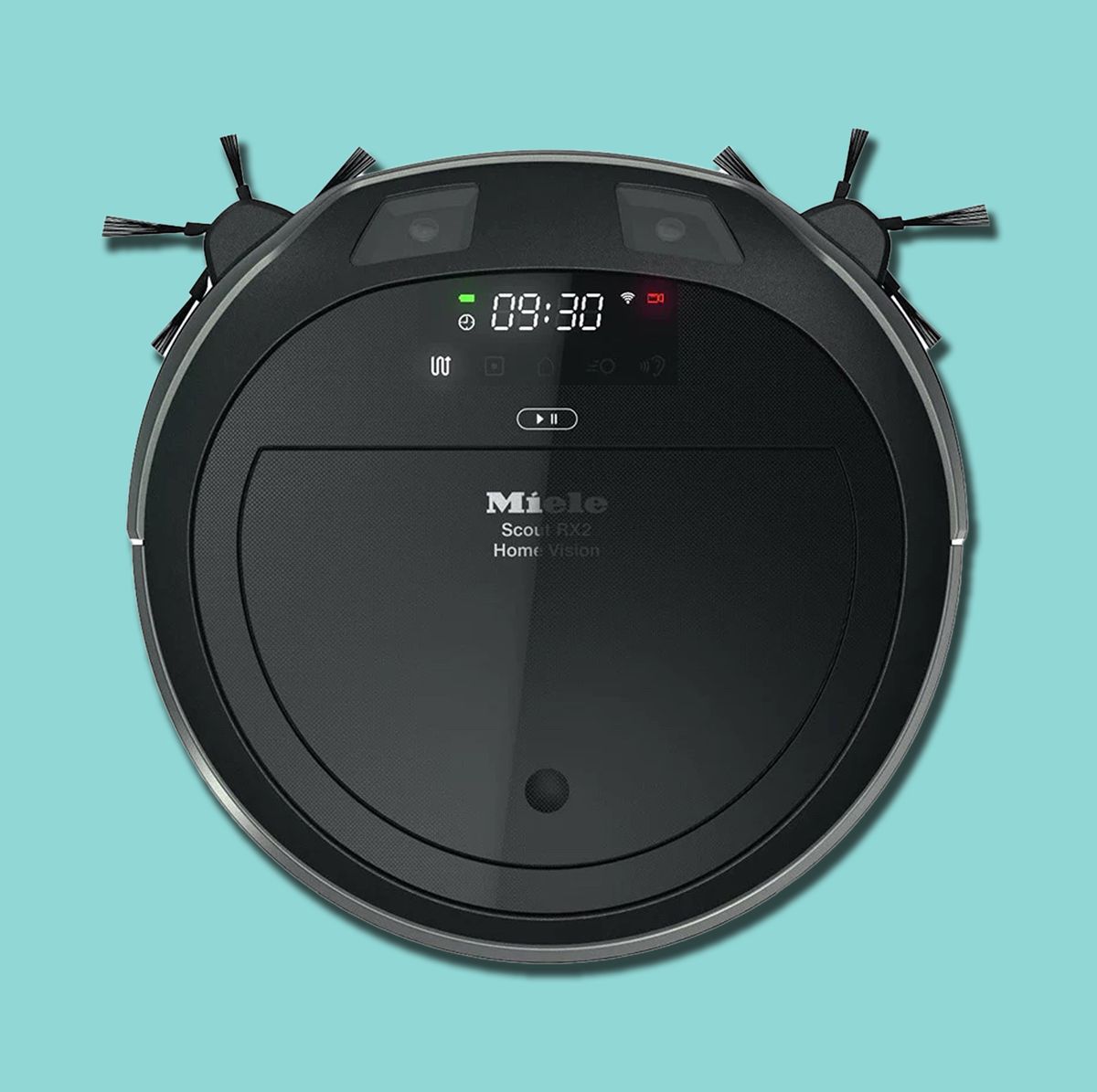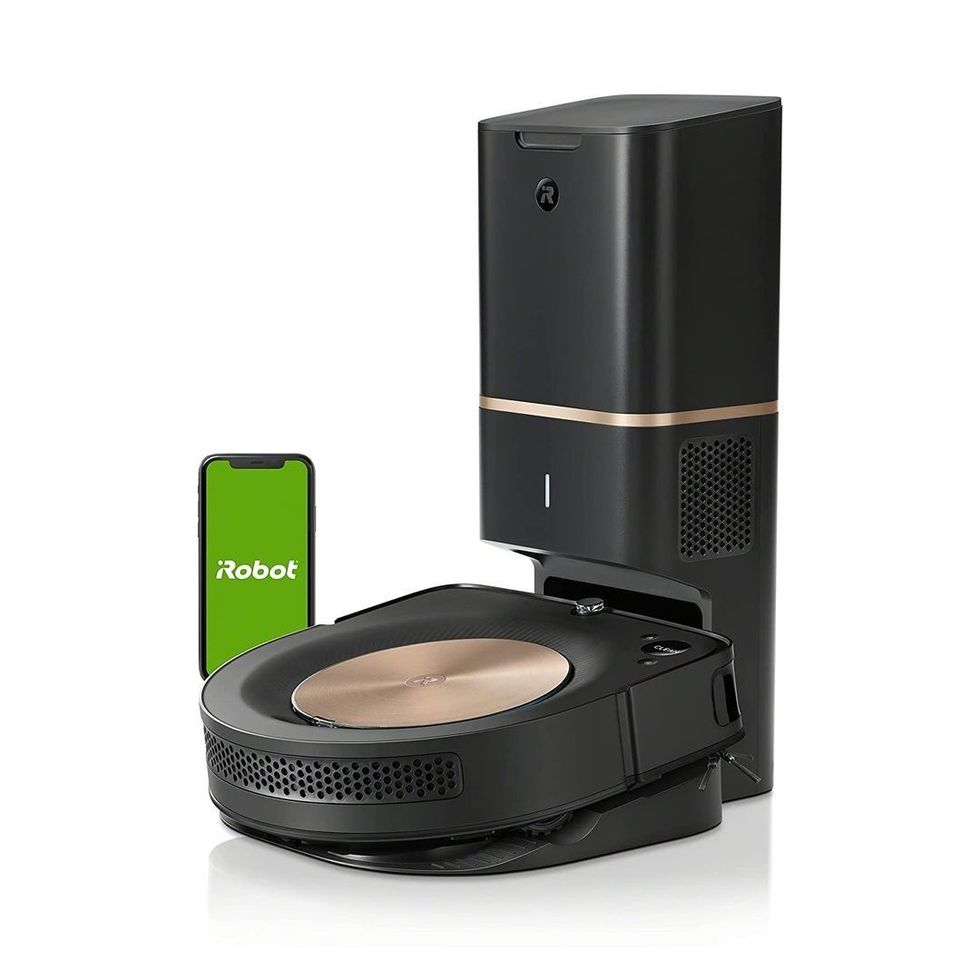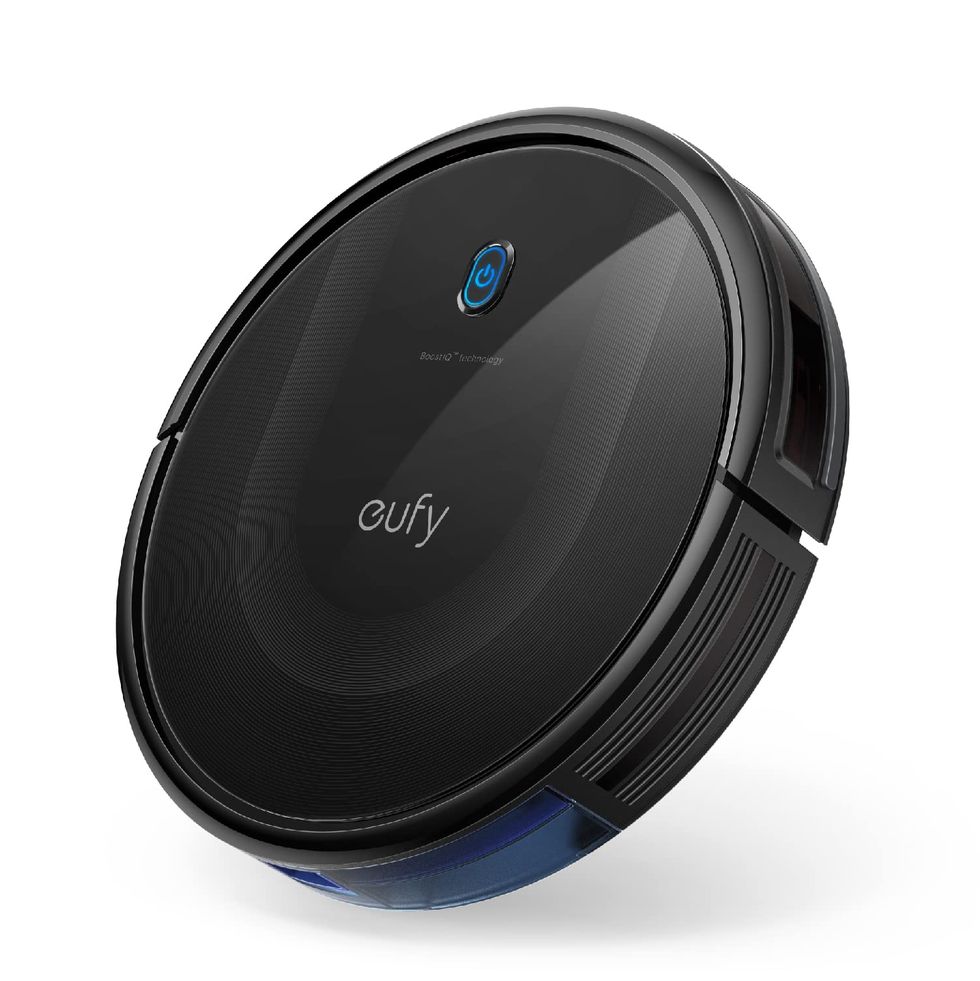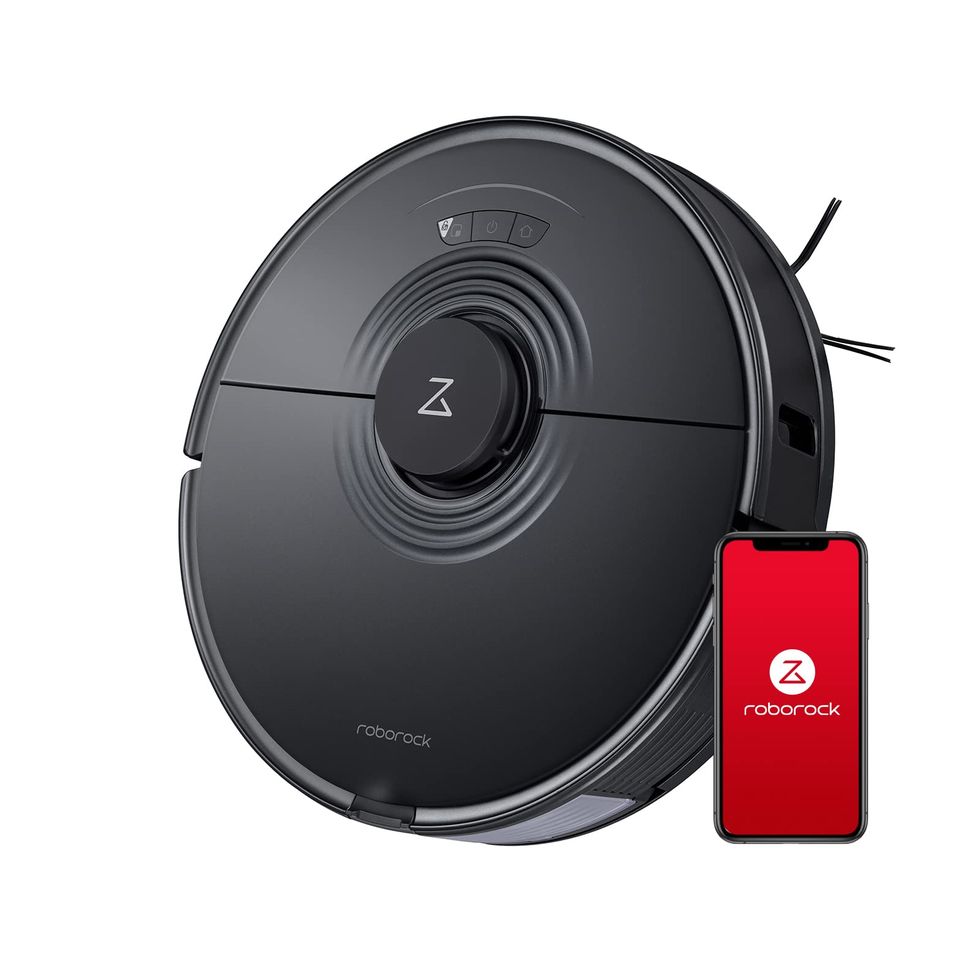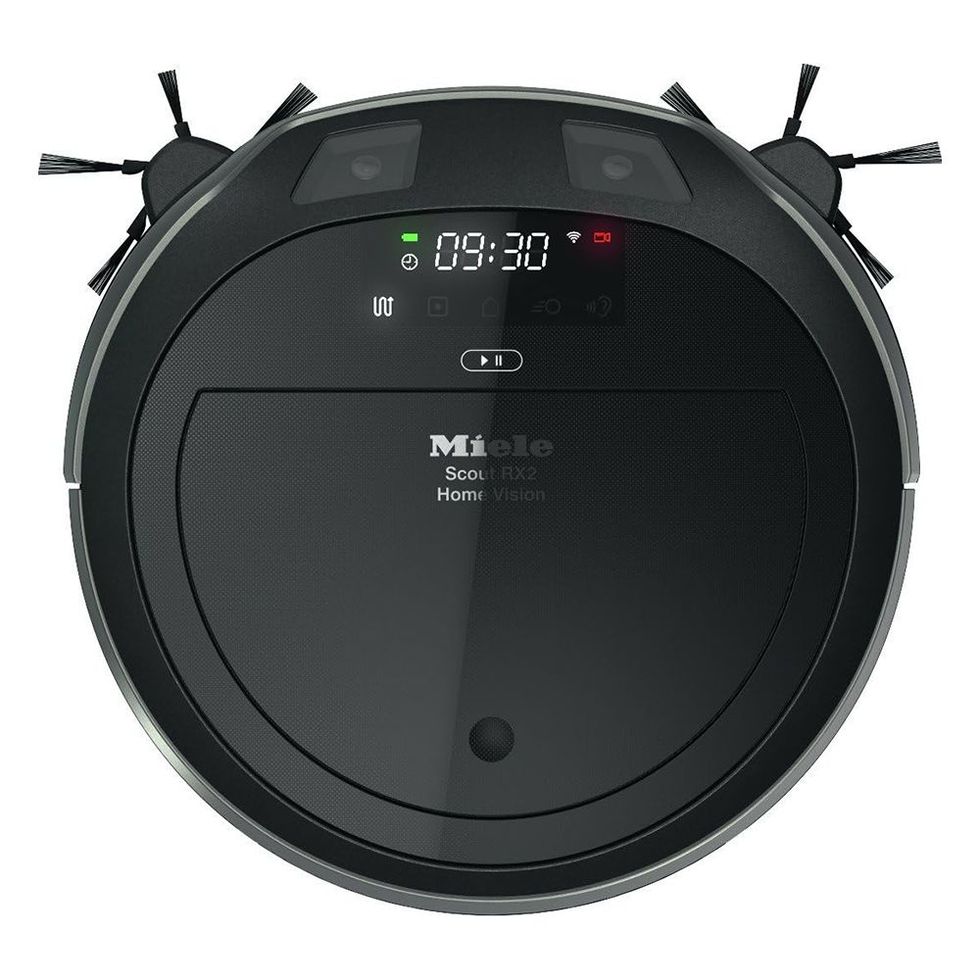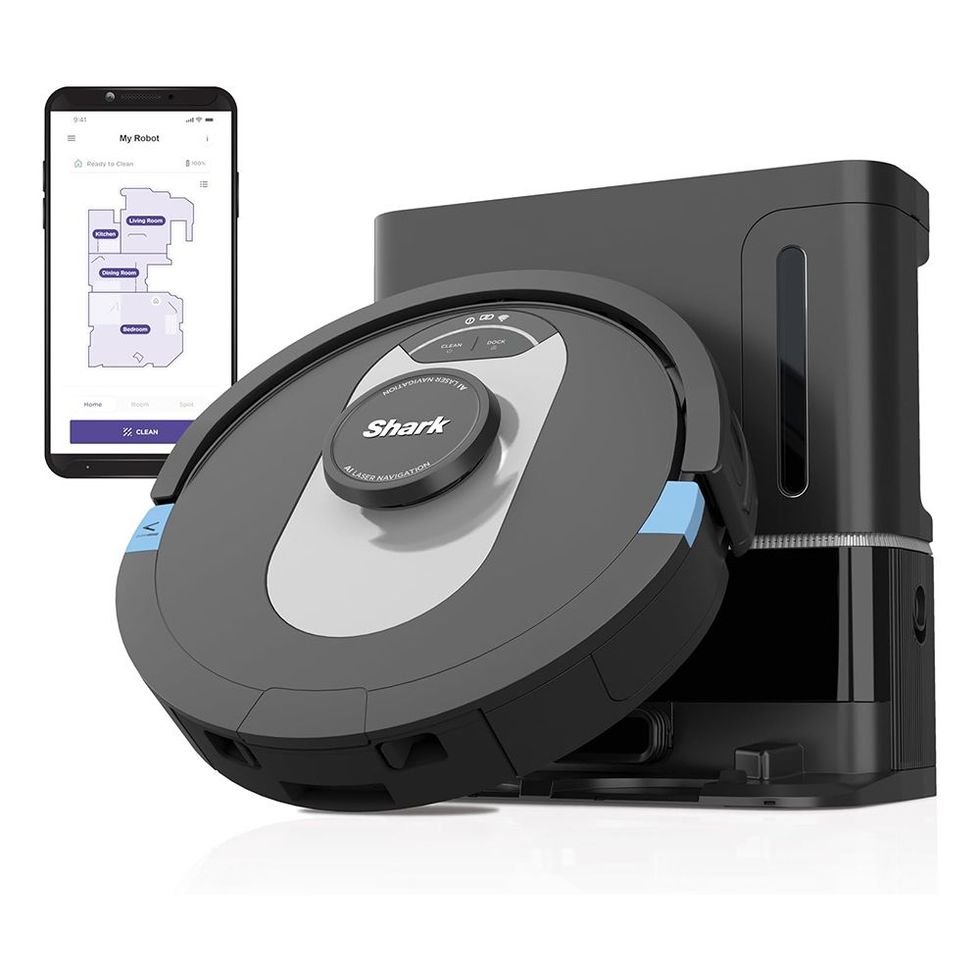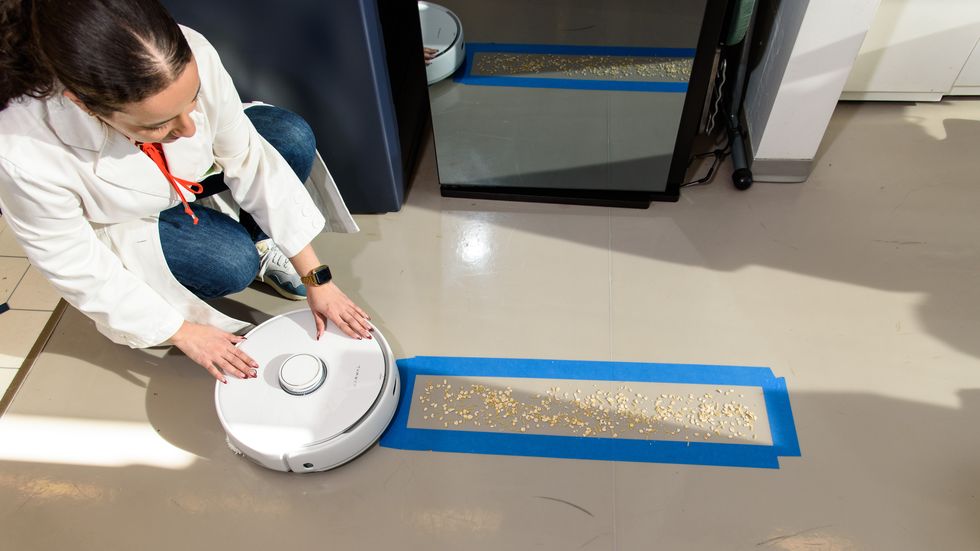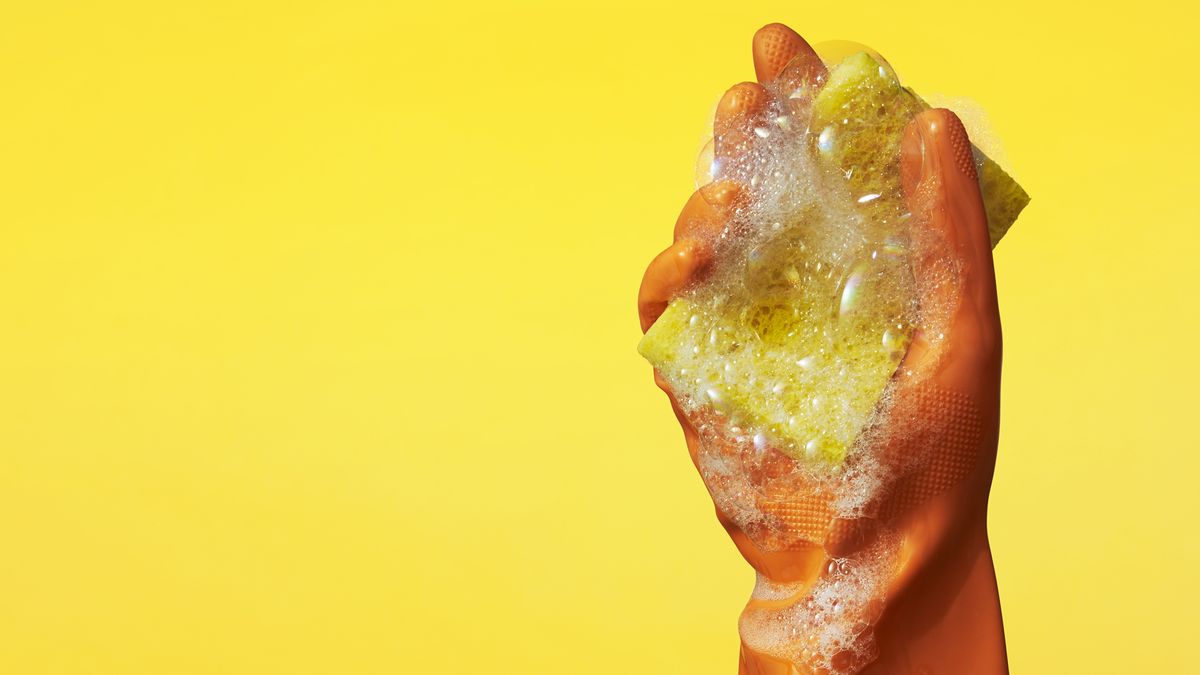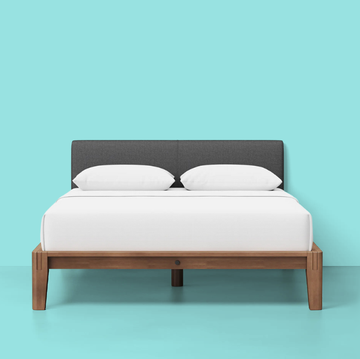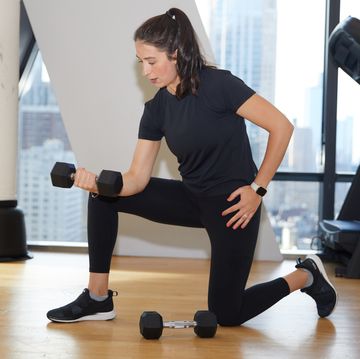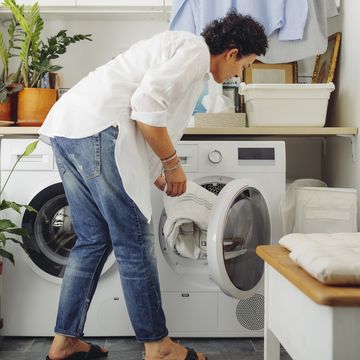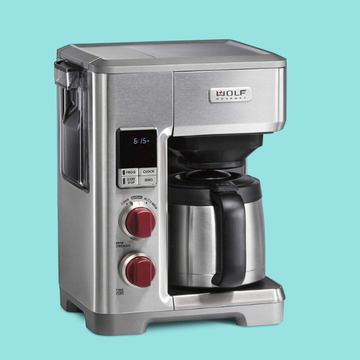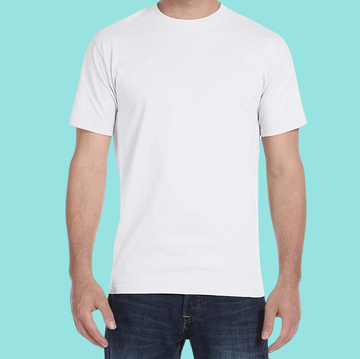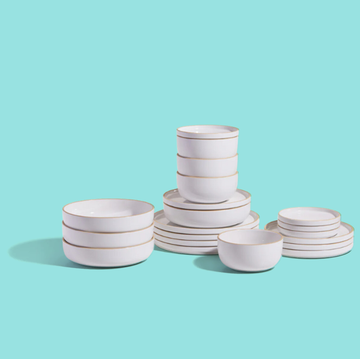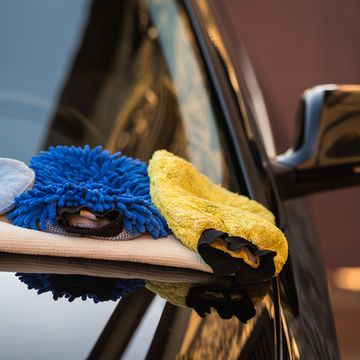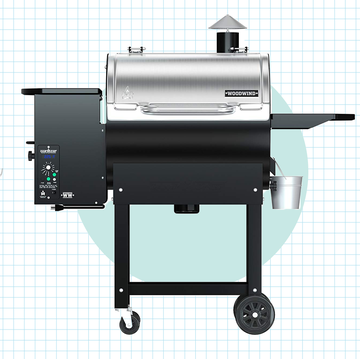Keeping floors clean is a never-ending challenge but promptly nabbing tracked-in dirt, crumbs, shedding pet hair and more makes a huge difference in how clean your home looks and feels. But who has time to constantly pull out the vacuum or broom? Let a robot vacuum do the job for you! While robot vacuums won’t totally make manual floor cleaning a thing of the past, they can make it something you need to do less often, and the good news is there are great models to be found at a variety of price points.
When we test robot vacuums and robot mops in the Good Housekeeping Institute Cleaning Lab, we set them loose in our custom-built two-room obstacle course. We observe how well they transition from hard floors to carpet (i.e., if they get stuck or not), how well they nab debris along walls and in corners, whether or not they can go under and around furniture and from room to room and if shoes, toys and other items we've placed in their paths trip them up.
Our top picks:
In the Good Housekeeping Institute Cleaning Lab, we test a lot of different types of vacuums to produce our constantly-updated hand-picked lists of the best vacuums, the best vacuums for pet hair and even brand- and retailer-specific lists like the best vacuums from Bissell and the best vacuums at Walmart. And when it comes to robot vacuums, there are more of them than ever, and they have come a long way from the very first iRobot Roomba we tested way back in 2002.
Robots can be more complicated to set up and operate than regular vacuums, so we look at how intuitive the controls are and how easy they are to program even for someone who is less tech-savvy. We also check how loud each vacuum is, whether or not debris or pet hair gets trapped anywhere and how simple the dust bin is to remove, empty and replace. We measure the amount of dry debris and pet hair they pick up from carpet and hard floors, plus take a close look at each robot’s accompanying app.
Ahead you can read more about how we evaluate robot vacuums in our Lab tests — plus a complete shopping guide and answers to your most frequently asked questions. If you’re looking for one that also wet-mops floors, consult our round-up of the best robot mops.
We have tested many Roomba robots in the last 20 years and it's not only the brand that started it all, but one that continually develops and introduces thoughtful, innovative features and products, like room mapping and object avoidance as well as the first mopping robot.
This iRobot Roomba s9+ is the second model from the brand to earn the top spot in our category tests of robot vacuums. It excelled in our hard floor cleaning tests, picking up 99% of the dry oats, sand, baking soda, nuts and screws that we spread out, snagging a spot on our list of the best vacuums for hardwood floors along the way. In fact, it performed so well that the only test where it earned less than a 99% pickup rate was in carpet pickup tests where the average pickup of all vacuums was just 73%. It follows a random pattern to clean so it took longer than many other models we tested to clean up a straight line of debris.
Like many other robot vacuums, it doesn’t clean right up to the charging base, but it cleaned more thoroughly than any other robot and its spot-cleaning function worked faster too. Some of our favorite features were the automatically increasing suction when it detects a carpet and that it can be adjusted to do two passes for an extra thorough cleaning.
Robot vacuums can be messy to maintain, but Roomba has features that make it easier to clean, like its self-emptying dirt disposal system that automatically transfers the dirt it has collected to the sealed, bag-lined dustbin in the charging base. And its easy-to-remove, self-cleaning roller brushes rarely required any maintenance at all because they didn’t clog with pesky pet hairs like models with bristle brushes did in our test, making it a great robot vacuum pick for pet owners with lots of pet hair to collect. Its high-efficiency filter traps irritating allergens but is not washable. Note that this was one of the noisiest robots we tested, earning a one-star rating from Quiet Mark and a “Quite noisy!” remark from our expert.
We found the accompanying app easy to use with a number of useful features like the ability to see the maps the robot makes of your home as it cleans, set a schedule for cleaning when you leave the house and designate areas as no-go zones to avoid any possible damage. Its voice command capabilities are one of the smartest we’ve tested, able to recognize when you tell your robot to clean under or around items in a room, such as “Clean under the dining room table,” for example.
iRobot is currently in the middle of a line update. We'll be testing the newest models soon, and this model may likely soon be replaced by ones with a redesigned, lower profile base and dust bin, which we love. And most of the new robots will also wet mop. If you snag it on sale at this great price, we think this model is a steal for all it offers. Otherwise, the Roomba j9+ is another great vacuum-only option.
The Eufy is packed with high-end features all at a price that's hard to pass up. And it's one of the most inexpensive models from Eufy. Its sleek, super-slim design (just under 3 inches tall) means it can slip beneath low ottomans and couches to nab even the most difficult-to-reach dirt. Previously, we included the RoboVac 15C Max as it was one of the quietest vacuums we tested, but it is currently sold out online.
We get great performance results from virtually every Eufy vacuum we test, so you should feel confident shopping the 11S Max, a very similar, entry-level option compared to the 15C Max, or stepping up to a higher-priced model with more features, like the RoboVac X8.
Eufy uses its BoostIQ Technology to automatically increase suction power when it detects an extra-strength cleaning job is needed. Its large wheels help it climb over door ledges and easily move from medium-pile carpet to hardwood or tile. With its advanced sensors, Eufy avoids any tumbles off ledges or stairs and doesn't bump into your furniture. There's a remote control for spot-cleaning or for cleaning just the edges of your rooms. Like most robot vacuums, Eufy knows to return to its charging base when the battery runs low to fully recharge before the next clean.
The Roborock S7 can vacuum and wet-mop your floors simultaneously, with an innovative sonic technology that scrubs floors up to 3,000 times per minute. Users with carpets up to 4 millimeters high don’t have to remove the mopping pads to vacuum. This robot will automatically lift the pads to avoid wetting carpets as they are detected.
Take note that the pads do need to be removed after each use and dried to keep the robot working in tip-top shape. The rubber main brush has the ability to float to meet uneven surfaces — a feature that sets this robot vacuum apart from other models we’ve tested. In our tests, we found it very easy to set up, though it does require almost 5 feet of empty space in front of and 2 feet to the sides of the charging dock for proper setup. It was loved by our consumer testers when we tried it in consideration for a previous Good Housekeeping Cleaning Award and was even named a winner by our panel of experts. One consumer tester noted that it struggled with pet hair on carpet — a common complaint with robot vacs.
Like our best overall pick from iRobot, the S7 has a rubber brush instead of one with bristles which helps minimize pet hair tangles and its white color is a refreshing change from basic black. A step-up model is also available with an auto-empty charging dock that can make cleanup even more simple and hands-free. All of the other vacuums from Roborock have more advanced technologies and fancier empty and docking stations, but do come at a higher price. The filter on this S7 is not HEPA, but it can be washed and is easy to pop out of the robot’s dustbin.
The S7 has some of the most extensive Amazon reviews we’ve ever seen for a floor-cleaning appliance and 73% of them are five-star ratings with dozens of users gushing about the vacuum’s great performance and their love for the Roborock app. One standout comment read, in part, “Download the app and what's this? No email required or accounts to sign up to? Awesome! The app itself is perfect, simple and the connection to the robot is flawless and lag-free.” When we tested the app in our Lab, we found it worked like a charm.
It lets you schedule automatic cleaning for different parts of your home, set boundaries for the robot around where you do and don’t want it to clean and view the exact route your robot vacuum has taken while it cleans. Plus, if a room in your home needs a little extra TLC (like the kitchen after you make dinner), you can easily set up different cleaning intensities with the app too.
With outstanding maneuverability, the Miele Scout RX2 Home Vision vacuumed through our Lab tests faster than any other robot vacuum we tested. This robot vacuum tackled every size mess efficiently and did it without bumping into any of the obstacles it came across. On bare floors, it picked up 98% of the dry debris we put down and though it struggled with our faux pet hair, getting most of it stuck in the bristles of its brush, it completed our spot-cleaning test in just one minute.
The combination of a 500 ml dustbin, over two-hour runtime and its speedy, bump-free clean-up make this model a great choice for large homes. It has a lot of modern features like two front cameras that transmit a live image feed via the app to your smart device plus excellent obstacle avoidance (one of the best we’ve seen). The Scout RX2 reaches deep into corners and edges and automatically increases its suction power when it detects a carpet, though it was significantly louder at the higher power mode. It also does not have the capability to set no-go zones in the app and does not have a HEPA filter.
From the Miele app, you can control the robot’s movements, see which rooms have already been cleaned and direct the robot to an area for spot cleaning. If you’d prefer not to be connected to your robot vacuum, you can completely remove the Wi-Fi module and use the remote control to schedule cleaning sessions. The cleaning tool for maintenance is installed in the dustbin, so it can’t get lost or misplaced, but the dustbin must be manually emptied each time. Like the many full-size Miele vacuums we’ve tested and included in our roundups of the best canister vacuums and best stick vacuums, this robot is sleek and maintenance is very easy. For a high-end brand like Miele, this model is a great price. Step-up models in the line are priced significantly higher.
Even before the first test, we admired Shark IQ’s compact footprint and streamlined design — impressive for a model with a self-empty bin. It was ready to go after only six hours of charging and with just the press of one button, off it went mapping our test spaces and smoothly navigating — not bumping — its way around and under chairs and other objects we put in its path.
It had no problem cleaning under kitchen cabinet toe kicks or figuring out how to clean tight spaces without getting stuck, though the LIDAR sensor at the top of the robot does make it a little too tall to get under some furniture. After methodically covering our test floors, the Shark positioned itself back on the dock and emptied every speck it picked up. Not only did it pick up what we put down, but it went back to nab one straggler that it missed on its first pass. Take note that as it empties the dustbin, it is quite loud, but it should only last about 20 seconds or so.
The dust bin in the self-empty base is extra-large to hold more debris and is easy to remove and empty. The filters in the robot and self-empty base are washable, but only the one in the base is a HEPA filter. Other notable features include its self-cleaning brush roll that prevents the hair tangles we see on other robots, an UtraClean mode that goes back and cleans the same area three times to get the most thorough clean possible and its ability to smoothly glide over the lightweight rugs and mats that often trip up other robots.
The SharkClean app makes this robot extra customizable, but for users who prefer not to use an app, you’ll find that the AI Ultra has a lot less to offer without it. Through the app, you can select which rooms you want to be cleaned and which you don’t, send the robot out to tackle high-traffic areas that need deeper cleaning or messes you need picked up in a hurry.
How we test robot vacuums
The Good Housekeeping Institute Cleaning Lab has been testing all kinds of vacuum cleaners for over 100 years. Using testing procedures developed by the International Electrotechnical Commission and ASTM International for testing robot vacuums, we spent almost 300 hours testing 15 robot vacuums, collecting a total of 405 data points that we then used to score each robot. And since this test, we've evaluated even more models.
In a 107-square-foot barricaded area made up of two rooms, we tested each robot’s performance in straight-line pickup and obstacle pickup on hard floor and carpet as well as the vacuum's maneuverability under couches, around tight corners, over bumps and across hard-floor-to-carpet transferring. In addition to performance testing, we tested ease of use, including how easy it is to use the model's controls, whether the initial setup is clear and whether it's simple to remove and clean all parts of the robot after use. We also rate how helpful we find the user manual for each.
For our hard floor straight-line pickup tests, large and small debris is deposited onto a marked area of the floor (based on the width of the opening of the robot vacuum’s nozzle). Then each robot vacuum is allowed 10 minutes to pick up the debris from the floor and the weight of the dustbin is taken to find how much debris is picked up by each. Straight-line pickup tests on carpet are done in an enclosed area where we deposit mixed debris including potting soil, sand and rayon fibers meant to mimic hair. Each robot vacuum is allowed to clean the carpet for a specified length of time, and the weight of the dustbin is taken to find out how much debris each robot can pick up.
Obstacle pickup tests are done across both rooms of our testing area with a mixture of oatmeal, orzo, baking soda and sand spread out around both rooms. Our robot vacuums are set loose, maneuvering under a couch and coffee table and traversing over an area rug and through a doorway to collect as much of the debris as possible. We calculate the pick-up percentage based on the weight of the dustbin after the robot vacuum is finished cleaning.
What to look for when shopping for the best robot vacuum
There are a few things to consider when choosing the best robot vacuum for your home.
✔️ Space: How big is your home? If your robot vacuum will have a lot of ground to cover, look for a model with a long battery life and a large dust bin. You don’t want your robot vacuum to have to recharge frequently during a single session. Models that recharge and then resume cleaning where they left off are also a great option for larger spaces.
✔️ Features: Robot vacuums now offer some pretty amazing features. One feature we think is absolutely necessary for any home is mapping capabilities that help guide the robot through your home instead of just bumping into furniture as it goes along. Some others we think are very useful are automatic carpet recognition, setting up no-go zones through an app and recharge and resume capabilities. But, not everyone will need all of these, and deciding which ones are important to you is a big part of choosing a robot for your home.
- Mapping Capabilities: Without a good mapping capability like LIDAR or 3D obstacle recognition, a robot will just bump around the objects of your home as it cleans, and every time it starts cleaning again, it will go around your home like it's the first time there. Without it, you won’t be able to view the robot’s cleaning route, send the robot to clean a specific room or spot (more on that below) or set up no-go zones.
- No-go Zones: Before robots could accurately map your floors with lasers and cameras, areas of the home you didn’t want your robot to enter had to be physically blocked off. Now, through most robot vac apps, you can set up virtual barriers to block off entire rooms or just small sections of a room. Homes with lots of areas to avoid (like kids’ playpens or dog beds and bowls) would benefit from no-go zone settings in the app. If you prefer not to use an app to control your device, there are still some options, like the Miele RX2, that come with physical strips to set up on your floors.
- Spot/Zone Cleaning: Looking for a robot that will clean under the dining room table after your kids have finished their dinner? Choose a robot with spot or zone cleaning modes. When you set these cleaning modes, your robot will clean just the area you choose either on the app or through voice commands so you don’t have to watch your robot clean the whole house before it gets to that one messy spot under the dinner table.
- Recharge and resume: Robots that recharge and then resume cleaning where they left off are especially great for large homes. If a model doesn’t have this, it will start to clean a room it already got halfway through from the very beginning again.
- Automatic Carpet Recognition: Models like our best overall pick, the iRobot Roomba S9+, can automatically detect carpet and increase the suction to better pick up embedded dirt and debris. This isn’t a make-or-break feature if your home has no carpets or if you plan to set your carpeted areas as no-go zones, but is especially important for robots that vacuum and mop. You don’t want to wet your carpets, and some robot manufacturers are now solving this problem with robots that automatically detect carpets and lift the mopping pads to avoid causing damage.
- Self-emptying: Self-emptying robots take up significantly more space on your floors than the smaller charging bases of manually emptied robot vacuums, but are a much more hands-free option. These bases can often go months without having to be emptied and for models that mop too, many have a water tank inside big enough to hold multiple cleaning sessions worth of water for your robot. Note that most manufacturers do not recommend moving the base after it has been set up so it’s important to pick a spot where it won’t be too obstructive or your robot will have to re-map your home.
- Scheduled Cleaning: For an even more hands-off approach to cleaning, look for a robot with a scheduled cleaning mode. After you set up the day and time you want to have a room cleaned, the robot will automatically get started on the task while you’re in bed or at work. Some robots will let you set different schedules for each room in your home, but others might just start cleaning every room each time.
✔️ Price: Robot vacuums can range anywhere from $200 to well over $1,200. Your budget will also determine what kind of features your robot vacuum may have — one with all the bells and whistles will likely be more expensive. If you aren’t interested in having a model with floor mapping or self-emptying capabilities, you can opt for a robot vacuum in the lower price range. Note that though there are options that cost under $100, we do not recommend a model that is that inexpensive and did not include any of these super cheap robot vacuums in our picks of some of the best inexpensive vacuums.
How do robot vacuums work?
Using navigation tools like sensors, lasers and cameras, a robot vacuum works its way around your home, suctioning up pet hair, crumbs and dirt into its dustbin from hard floors like wood, tile and laminate and low pile carpets and area rugs. High-end robots often have the capability to map and learn your space, so you can set the robot to clean only one room or a specific area, while cheaper vacuum models include boundary strips that you place on the floor to keep the robot where you want it. Even inexpensive models have fall-detection sensors that keep them from tumbling down stairs.
Many vacuums are "smart" and work with apps to help you schedule cleaning sessions, and some sync with Amazon’s Alexa, Google Assistant and other digital voice aids for a truly hands-free experience. All robot vacuums automatically return to their charging docks to recharge, and some can even pause a cleaning session, recharge and continue cleaning from where they left off. If you have pets, consider a model with a rubber brush roller. We found it was easier to clean pet hair and lint off a rubber brush roller than a bristle brush roller.
Before your robot starts cleaning, pick up small items you don’t want to be vacuumed (check under the bed!), and ensure that power cords, clothing, rug fringe and window blind cords are tucked away. Unless you’re using a wet-mop vacuum, clean up all wet spills. After cleaning, empty the dust bin and wipe down the sensors and charging contacts with a soft cloth so the robot can navigate more accurately and make a better connection with the charger.
How to clean a robot vacuum
Robot vacuums shouldn't require much cleaning, but all robots have different cleaning and maintenance requirements specific to that model. There are things you can do to keep your robot working in tip-top shape like removing any hair tangled around the brushes, emptying (and rinsing if the manufacturer says it's okay) the dust bin on the robot after each cleaning session and wiping the sensors or cameras to make sure that your robot can see your home well for the next cleaning session.
For robots that mop too, it's important to remove the mopping pads, clean them and then allow them to dry before re-installing them on the robot. Or, you can buy a robot that washes and dries the pads after each cleaning session, like the Dreametech W10 that earned a spot in a previous Good Housekeeping Best Cleaning and Organizing Awards. If your manufacturer recommends it, you can also periodically rinse your robot's filter, allowing it to dry before re-installing it and replace it when you notice your robot's suction isn't as good as it used to be or however often is recommended.
Are robot vacuums worth it?
While no robot can manage stairs or tackle ground-in dirt and debris as well as a stick or upright vacuum (yet!), the top performers in our tests do have impressive pick-up scores on hard floors and low-pile carpets. They do well at sweeping up fine particles like sand and baking soda, heavier debris like oatmeal, orzo pasta, metal screws and nuts and even fluffy stuff, like pet hair.
Consider investing in one if you absolutely hate this chore or want your home cleaned more often than you have the time or energy for. Robot vacuums are great maintenance cleaners. Send them out several times a week, and they’ll nab all the dust and pet hair, lint and surface dirt on your floors before it has a chance to build up or get ground in.
Another benefit is that robot vacuums clean under the bed, behind furniture, along the walls and in the corners that you might often skip or that your regular vacuum can’t reach. (All of the vacuums we tested have brush rollers to lift away pet hair and were slim enough to clean under furniture at least 4 inches high; most featured side brushes to help scoop dirt from deep corners and edges.) They’ll clean just the kitchen floor after dinner while you catch your favorite show or an entire level of your home while you’re out of the house. Can you get it done faster with your regular vacuum? Sure. But the real question is, do you want to?
How long do robot vacuums last?
Robot vacuums can last just as long as full-size vacuums with proper care and maintenance. This means that as long as you are cleaning the rotating brushes regularly (hairs will get tangled here!), replacing parts as needed and using your robot vacuum according to the manufacturer’s instructions, it’ll be helping you keep your home clean for years to come. Robot vacuum manufacturers we've spoken to have shared stories of consumers owning the same robot vac for nearly 10 years (with replaced wheels, rotating brushes and batteries).
Why trust Good Housekeeping?
Carolyn Forté, the Good Housekeeping Institute's Home Care and Cleaning Lab Executive Director, has over 40 years of experience testing and writing about all kinds of vacuums. For this roundup, she oversaw all of the testing conducted by Lynn Redmile, the testing and product review analyst who conducted our Lab's last full category test of robot vacuums where three of the picks on this list came from. Two of the newer picks in this story were tested by Carolyn personally and by our panel of consumer testers in consideration for the most recent Good Housekeeping Best Cleaning and Organizing Awards.
Jodhaira Rodriguez was previously a product reviews analyst in the Cleaning Lab who researched and tested cleaning appliances and other products. She tested all of the robots that were submitted for awards in this year's Best Cleaning and Organizing Awards and contributed information to this story.
Carolyn Forté brings more than 40 years of experience as a consumer products expert to her role as executive director of the Good Housekeeping Institute's Home Care and Cleaning Lab. Using deep analytical testing and writing expertise in appliances, cleaning, textiles and organizational products, she produces cleaning and home care advice for GH, has authored numerous books and bookazines for the brand and partners with the American Cleaning Institute to co-produce the Discover Cleaning Summits. She holds a bachelor's degree in family and consumer sciences from Queens College, City University of New York.
From 2021 to 2023, Jodhaira (she/her) was a product reviews analyst in the Good Housekeeping Institute’s Home Care & Cleaning Lab, where she tested and wrote about home appliances, cleaning products and cleaning tips. Prior to joining GH, she graduated from Hofstra University with a bachelor’s degree in forensic science and spent two years as an analyst in an environmental lab in Queens.

Lynn Redmile (she/her) is a contributing product reviews analyst at the Good Housekeeping Institute, where she's been evaluating nutrition, fitness, beauty, textiles, home, pet, and cleaning products since 2012. She brings over 30 years of data analysis and project management experience to the role.
